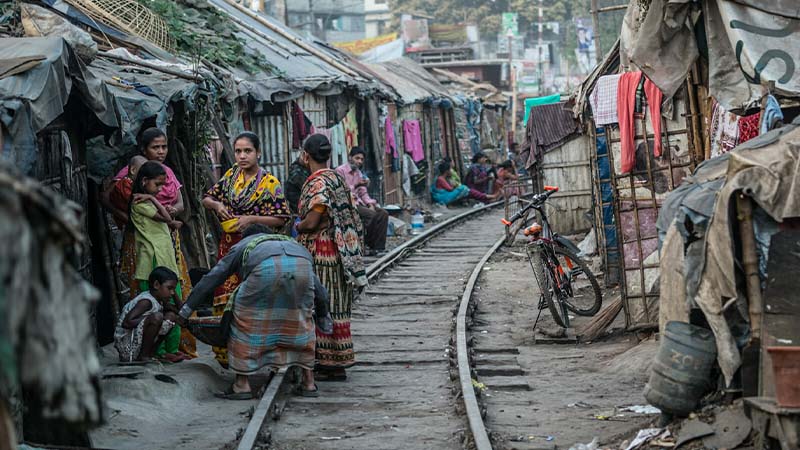GET IN TOUCH
- Please wait...

Truth be told, we are not even close to beating poverty as a nation. We have a long way to go. As of 2010, 76.5% of the population lived below $2 a day (at PPP) down from 93% back in 1992 while 43.3% lived below $1.25 (at PPP) down from 70.2% in 1992. This translates to an annual poverty alleviation rate of 1%, which is disappointing considering the fact that we have been growing consistently at a rate of about 6 % over the decade.
However, this news should not surprise us due to inequality in income in Bangladesh. So, what can be done to alleviate poverty at a faster rate?
Increasing budget allocation for education
We have to increase the human capital of our population. As of 2011, less than 2% of the Gross National Income (GNI) was spent on education. This number must rise as most emerging economies have a rate of over 2.5%, with neighboring India and Thailand spending 3.1% and 4.1%, respectively.
The increased spending should be geared toward rural areas to increase the number of students attending primary and secondary schools. On top of that, more vocational training institutes should be set up in all divisions.
A good start would be to set up these institutes under present public universities. This will equip the poor with the skills to avail better economic opportunities and improve their living standards.
Increasing micro-credit and micro-finance outreach
Micro-credit first attained prominence in Bangladesh, and we should use this to our advantage. The poor lack capital. Credit needs to be available to those who need it the most but are denied by the conventional banking system. We already witnessed the wonder of Grameen Bank and BRAC in lifting millions out of poverty.
With higher human capital derived from better education, as stated above, the poor will develop skills to productively use credit to start their own businesses. In a nation such as ours, education is not an end in itself.
Education will be futile if economic opportunities are not created. Micro-credit and micro-finance have the ability to do that. It will let the poor create their own opportunities.
Hence, we need to increase micro-credit outreach through both public and private sector initiatives to ideally reach poor youth.
Improving agriculture
Around 45% of our labor force, primarily poor, is directly involved in agriculture. A lot could be done to improve their lives.
We could begin by ensuring fertilizer, seeds, and power for irrigation reach farmers on time. More investment should be made in hybrid crop research so that more high-yielding strains of crops are developed on a larger scale.
At present, farmers do not receive appropriate remuneration for agricultural produce.
To this end, the government should take initiatives to ensure farmers receive a fair share of the revenue by curbing the oppressive nature of middlemen in the agricultural supply chain. The government could increase its own “direct buying” operation to pay a fairer price to farmers.
With proper supervision, such ventures can even become profitable for the government. At the same time, it should take initiatives to increase global market outreach of Bangladeshi agricultural produce, which, in turn, will further benefit farmers.
Promoting newer industries
The government must develop effective policies to promote newer industries in the country, such as leather, shipbuilding, agricultural product processing, plastics, low-end electronics, etc., and find international markets for them. This will in turn create more employment opportunities for the poor.
Increasing expenditure on infrastructure development
The government should build and improve roads and highways across the country, to improve connection with national and divisional capitals and land, river, and seaports. This will help in spreading industries across the country, creating employment opportunities for many in Bangladesh living further away from present industrial hubs.
For example, important infrastructural projects like Padma Bridge must be completed to increase connectivity of the country so that transportation costs in terms of money and time decrease for businesses, who can reap the advantage of cheaper land prices in Southern parts of Bangladesh.
Power production and outreach must increase fast. At present, Bangladesh has one of the lowest per capita power consumption measures, even among low-income nations.
We only produce a little over 6000 MW. This capacity must be increased to 20,000 MW within the next 7 years. Economic opportunities for the poor will certainly grow with increasing rural power connectivity.
Decentralizing Dhaka
Dhaka is overcrowded. It’s about time Bangladesh develops another city within a 30 km radius of Dhaka. The government should begin by moving the secretariat, government offices, and nationalized company headquarters to this new, planned city.
Eventually, other private sector businesses and service providers will be attracted there as the population of the city grows. In the short run, this will create a massive infrastructure development project, which will employ several thousand low-income people.
Eventually, the poor will find better-paying jobs and better economic opportunities to serve the needs of this new city. Reduced pressure on Dhaka will provide additional benefits.
Attracting FDI and branding the nation
This is nothing new. The government must take initiatives to improve the political scenario and labor conditions to attract foreign direct investment, which will create newer economic opportunities for thousands of poverty-stricken people. The nation needs to eventually be branded as an investor-friendly emerging economy with a skilled workforce and improved working conditions.
I know I am speaking ahead of time for most of you but these plans are certainly attainable within the next ten years with proper planning and governance.
However, we cannot complacently sit around as very little of the fruits of the 6% growth rate are reaching the people who need them the most.
Source: Dhaka Tribune
Our experts can help you solve your unique challenges
Stay up-to-date with our Thought Leadership and Insights